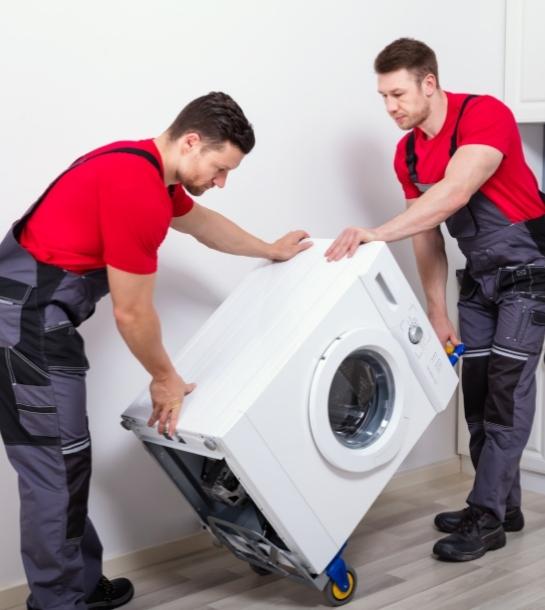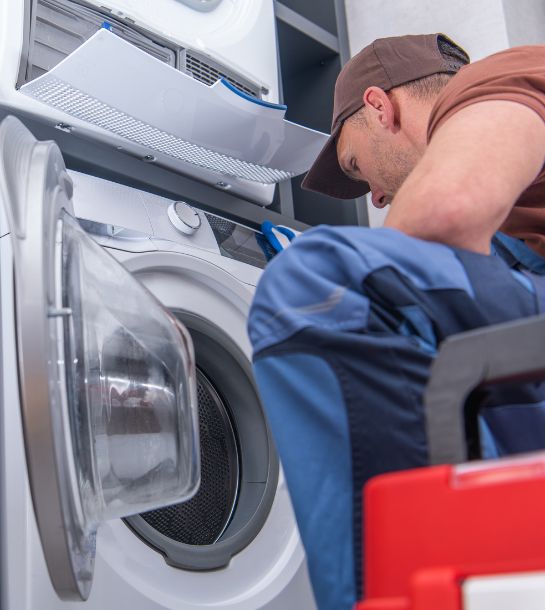| Failure Code # |
Description of Fault Code |
Solution for Fault Code |
| 4 Digit Failure Codes (for 2 digit codes see below) |
| F1 – E0 |
EEPROM communication error |
1. Disconnect power for at least 30 seconds.
2. Re-apply power and observe for at least one minute.
3. If code re-appears, replace control board (also called ERC or clock). Note: Applies to all F1-E… codes except F1-E3. |
| F1 – E1 |
EEPROM checksum error |
| F1 – E2 |
UL A/D error(s) |
| F1 – E4 |
Model ID error |
| F1 – E5 |
Calibration shifted |
| F1 – E6 |
Latch signal mismatch error |
| F1 – E9 |
Stack overflow |
| F1 – E3 |
Wiring harness cavity size does not match previously stored value |
The “Cavity Size Select” jumpers in the wiring harness indicate a cavity size different from that which the control was previously configured for. Check the jumpers in the harness to make sure they agree with the actual oven size. |
| F2 – E0 |
Shorted keypad (also called touch pad) |
1. Check keypad connector for firm connection (keypad connects to control board).
2. Press CANCEL. If error code returns after 60 seconds, replace keypad (also called touch pad or membrane switch). Some models incorporate keypad in to control board as one unit. In this case, replace control board (also called ERC or clock). |
| F2 – E1 |
Keypad cable unplugged |
| F2 – E5 |
Cancel key drive line open |
| F2 – E6 |
Cancel key drive line open |
| F3 – E0 |
Oven temperature sensor (RTD) opened (upper oven, if double oven) |
Replace Oven temperature sensor (RTD)
Note: Applies to all F3-E… codes. |
| F3 – E1 |
Oven temperature sensor (RTD) shorted (upper oven, if double oven) |
| F3 – E2 |
Oven temperature is too high (Cook mode) |
| F3 – E3 |
Oven temperature is too high (Clean mode) |
| F3 – E4 |
Oven temperature sensor (RTD) opened (lower oven, if double oven) |
| F3 – E5 |
Oven temperature sensor (RTD) shorted (lower oven, if double oven) |
| F3 – E6 |
Warming drawer sensor open |
| F3 – E7 |
Warming drawer sensor shorted |
| F4 – E1 |
Meat probe malfunction – shorted |
Problem could be with the probe, the receptacle, or probe circuit. Check probe. Look for pinched wire. Look for condensation or contamination on probe receptacle. Replace probe if all else checks out ok. |
| F5 – E0 |
Door switches do not agree (condition exists when door switch is closed indicating an open door, and latch switch is closed indicating a locked door) |
1. If door latched:
A. Disconnect power from unit.B. Check wires and connectors from control to door switch, then from door switch to control. If no damage to wires and all connectors okay, proceed to step C.C. Replace door switch.D. Re-apply power.E. Press and hold any key down for 1 minute to clear F5 failure code from memory. F2 will appear. Press CANCEL and observe for 1 minute to ensure operation is correct.
2. If door not latched:
A. Disconnect power from unit.B. Check wires and connectors from control to latch switch, then from latch switch to control. If no damage to wires and all connectors okay, proceed to step C.C. Repeat steps A and B for door switch.
3. Measure door switch (door open = switch open small low voltage terminals). Replace switch if defective.
4. Measure latch switch (unlatch = switch open, CAUTION – oven light contacts are closed). Replace switch if defective.
5. If corrections are made in any step, reconnect power to control. Press and hold any key for 1 minute to clear R failure code from memory. F2 will appear. Press CANCEL and observe for 1 minute to ensure operation is correct.
6. If failure remains, disconnect power and replace control. Note: Applies to all F5-E… codes. |
| F5 – E1 |
Self clean latch will not lock |
| F5 – E2 |
Latch during CLEAN error |
| F5 – E5 |
Self clean temperature not reached within 45 minutes. |
| F5 – E6 |
Door is open, but latch is locked |
| F5 – E7 |
Self clean latch will not unlock |
| F6 – E0 |
Return line not connected |
If switch pulse return line is not connected, electronic control will display F6 within 60 seconds after power up. Replace control. |
| F7 – E1 |
Common switch wire is defective |
Common wire (+5VDC) to latch switch, and to door switch is shorted to chassis ground or neutral. A double oven will have two of each switch and one common wire.
1. Check connections at control and at the latch switch and door switch.
2. If all connections are good, then check the individual switches as outlined for the F5 failure. |
| 2 Digit Failure Codes |
| F0 |
Board failure |
Replace control board (also called ERC or clock). |
| F1 |
Board failure |
Replace control board (also called ERC or clock). |
| F2 |
Oven temperature is too high |
1. Look for welded relay contacts on bake or broil relays. If this happens, replace oven control (also called clock or ERC).
2. For SELF CLEAN models: check door lock operation.
3. Look for a high resistance connection or any other cause of high resistance in the oven temperature sensor circuit. Check sensor, sensor harness and sensor harness connection at sensor and oven control. Replace sensor if found defective. Remember: Oven control (ERC) measures resistance of sensor circuit, not actual oven temperature. |
| F3 |
Oven temperature sensor (RTD) open |
Replace Oven temperature sensor (RTD) |
| F4 |
Oven temperature sensor (RTD) shorted |
Replace Oven temperature sensor (RTD) |
| F5 |
Board failure |
Replace control board (also called ERC or clock). |
| F7 |
Function key stuck on ERC |
Replace control board (also called ERC or clock). |
| F8 |
Board failure |
Replace control board (also called ERC or clock). |
| F9 |
Oven door lock failure |
Check wiring to door lock switch (the wire harness may be connected wrong). Check for stuck lock switch. |





